|
|
Freddy Moore:
|
"I was born by The
River in a little metropolis"
"One of my proudest
accomplishments, as a songwriter, was seeing my compositions side-by-side
with songs by Kink: Ray Davies, and fellow
L.A. songwriters: Brian Wilson, Danny
Elfman, Joan
Jett, (and others), on albums compiled and released by Rhino
Records."
|
Reader Magazine:
|
Moore's band was later
acknowledged by no less than Creem magazine as having
been one of the first power-pop bands known to man.
|
Bob Cavallo,
Mgr of
Prince, Lovin' Spoonful,...
|
"Freddy Moore will one day be
acknowleged as one of the great lyricists of his
generation."
|
|
By Tom
Murtha
Insider Magazine
1972
|
Frederick G. Moore was born in
Minneapolis, Minnesota. He was called 'Ricky' by his friends and
family. Each year when each new teacher would call "Frederick
Moore?" Moore would ask to be called 'Ricky', the teacher would
immediately dub him either 'Ricky Ricardo' or 'Ricky Nelson'.
Thereafter Moore knew he'd end up being a singing guitarist
someday! "I was always drawn to stringed-instruments: ukuleles,
violins, and guitars." When the Beatles hit the US in 1964 Moore redoubled
his efforts to master the guitar. Four months later (June 1964) he moved
to California. He grew a Beatle
cut and got into hassles with surfing, hot rodding school associates. "I didn't
have any friends and really didn't want any. I just sat in my
room and played Beatle songs and wrote my own." Moore poured through rock fanzines,
absorbed and dissected every Beatle album that came out, and listened
exclusively to the Fab Four and the Kinks. By October 1964 he had
unequivocally decided his vocation was playing rock and roll music and he
started writing. "I noticed on the record labels that the Beatles wrote their
own songs, so I figured that to be a professional rock musician I should write my own
songs."
| "In the summer of 1964,
right after 'A Hard Days Night' came out, my cousin
Dann
Wick
and I spent two weeks making wooden replicas
of the Paul McCartney bass, the John Lennon rhythm guitar, George Harrison's
lead guitar, and Ringo's drums. We used to lip-synch to records. Danny
and I wanted to play real music, the others wanted to lip-synch, but we
finally got them going. We learned 'You Really Got Me' by the Kinks, the
Beatles' 'And I Love Her' and my first original composition
'Baby Be Mine'." | 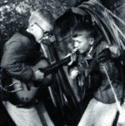 |
Moore pursued his musical
ambitions with the same vigor most 13 year-olds apply to major league baseball
aspirations. He started putting together bands and teaching reluctant copycat
cohorts to play his songs. His narrow interests and extreme diffidence made
finding other players difficult. "When I was in the tenth grade, a new guy moved
into our neighborhood. I had heard he played guitar, so one day when he was
walking down the street I put my amp in the window and played my guitar at him
to attract his attention." The two got Moore's first serious group together, but
in January 1966 Moore returned to Richfield with his parents.
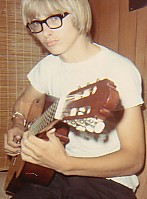 |
Moore continued his
apprenticeship with the media in Minnesota, keeping to
himself, teaching friends to play, writing prolifically, and
growing up with the music, always one step ahead of the
trends. He and friend, Steve Brenner
spent summer afternoons writing more songs and
arranging them for ensembles of fluctuating size. The groups would meet
early in the day, rehearse the previous day's song, discard it
or tape it, and then begin work on another
song.(When Brenner was not available Moore collaborated with
his cousin
David Burdick
another prolific songwriter).
|
Moore did the same
thing with other people's music playing through works like the
Beatles 'white album' at a rate of two or three songs per day.
"During the summer of love, Craig Laursen and I sat in the basement and turned out
all the lights and jammed out San Francisco music. We alternated
rhythm and lead for a million hours." By the end of the summer,
Moore was a creditable lead guitarist.
Moore's listening interests
broadened, and he continued to single-mindedly pursue guitar virtuosity
and related skills like arranging and recording music. When he graduated
from Richfield High
School in 1968, the outside world intruded in
the form of the draft. To escape, he enrolled at the University of
Minnesota to study Music Theory and Composition under composer Dominick Argento.
For Moore, who had spent most of his
youth hunched over a guitar and tape recorder in his bedroom, his
college years were a watershed experience. "I found an organ in
Scott Hall, and I was playing around with that one afternoon and
somebody came in. I thought I must be using his organ time or
something, but he said it was alright, and that he'd show me how to
use it, which he did." The organist (Randy Pink) said he
was forming a group(
The Pink Project),
which never made it beyond the rehearsal stage, but before his
association with Moore ended, he had interested him in Thelonius
Monk and other jazzmen, besides starting him on keyboards. "I'd go
to school and play piano all day, and I started missing classes."
"When I got into U music, professor Argento would illustrate his points by pounding something on the piano.
It always came out sounding like the Mothers. I thought it was pretty cool,
so I started listening to the Mothers more." Frank Zappa joined Lennon, McCartney,
and Ray Davies as an audible influence on Moore's writing.
Moore's Richfield reputation grew on a small scale. The local
cover band (Escher,
Winger,
Weiss and
Bates) paid a visit to
the reclusive songwriter and asked him to
supply them with some original compositions, after he had taught
them several of his newest songs they asked him to
join. Moore refused politely, but said they could join HIS group.
| The group became An English Sky, after one of
Moore's songs.
Mark Winger
was among
the members, and he and Moore collaborated on arrangements. "I
would make up a guitar part and teach it to Winger, and he
would teach the part he wrote to the other guitarist and then
I'd make up another part." Moore taught the rest of the parts
to the group members,
By Fall, 1969, Frederick G. Moore had
written out the chords, melody and lyrics for over 90 songs;
forgotten or lost perhaps 90 more; begun his second year of
college, learned to arrange, score, play guitar, piano, organ
and drums, still wanted to be a rock star, and had rarely
played in front of an audience. He was 19. |  |
An English Sky were invited to perform at the rock
festival an Edina junior highschool was having on the school loading dock. Moore
proposed the matter to An English Sky, and they turned him
down flat. He went over to
the Euphorium one night and taught some of his tunes to the band
Euphoria, and did the gig solo - his first official performance as
'SKOGIE' Moore. Then followed several weeks of rehearsals with An English
Sky with Moore. Euphoria, and 'Skogie' with Euphoria. Finally the two groups formed one
10-man unit. Moore wrote a letter and fired everyone but himself and
Goldstein,
hired 3 people back, and formed Skogie and the Flaming Pachucos phase I. Note: Around this time
Moore met his first wife Lucy (their relationship lasted 9
years.)
Rehearsals were 7 nights a week when there are no gigs,
The Euphorium was a corner basement room with 5 years of rock music
caked on the walls in Day-Glo paint. The only window was splintered
from having amplifiers pushed through.
The Euphorium was carpeted with wires and partly lined with eggshell
cartons. Mounds of crushed paper paid tribute to Moore's mania for
list making: lists of songs, lists of equipment for every
eventuality, and finally, the shirk list adorn the walls. Shirk list
honors went in the form of shirk-iota's to the man who dreamt
up the heaviest method of circumventing work. Moore always won.
The Pachucos spent most of their
rehearsal time working out complex song arrangements. Moore pulled
thirty songs from the 200 he had written out or saved on tape and each
week a new one was drawn out of a hat. A song was usually ready for
performance after one week of arranging and an additional week of
rehearsal.
The band would close down rehearsal at
the Euphorium any time from 10:30 to 12 PM, and sometimes would go all
night. Arranging the never ending stream of work from as prolific a
composer as Moore, could get tedious and often did when ideas were
sparse. The situation was complicated by the group's obsession with
doing things unconventionally or conventionally, but better than
ever before.
Moore's day would begin a
few hours after the previous evening's rehearsal ended. Sleep and getting a
driver's license fell into the same category for Moore: things for which he
didn't have time. Getting out of bed in the morning, he reached for his guitar
before his toothbrush. His suitcoat was stuffed with lists, notebooks and guitar
picks, as well as a portable toothbrush he could use when he had a moment.
No matter what time he got up, at 12:00 noon sharp he worked on
one or more of the 13 songs he was presently writing. He usually didn’t write
anything down until it’s completed, so as many were lost as finished. Afternoons
were also the time he used to pursue his personal research projects.
Moore also had a massive
tape collection, including reels of nearly every musical group he has ever put
together. Some of The Pachuco's repertoire was in its fourth or fifth
arrangement. Some songs such as "Magic Lock" go back to early 1967.
"Colonel Arnold’s Cross," "Collins Park Rock," and "Wolfman
Strikes Again" date back to 1968. Moore recalls how he wrote the latter: "I
wrote that the night Morrill Hall at the U of M was seized by anti-war protesters. I saw something
happening at Morrill, and I got up on this pediment to see, and I slipped and fell
about ten feet down into this contruction pit. I thought of the first line just as these
protesters were pulling me out, and I wrote the rest of the song as I was walking down
the campus mall. When I got home it was pretty hard to figure out the chords because
all I had were these words and melody in the back of my mind."
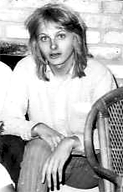 |
Moore wrote whenever an
idea hit him. He’s written songs riding his bicycle to the store
("Blueberries For Baby"), lying on a pool table at MacPhail Center while
waiting for a ride ("Tonight’s The Night") and when
inspiration reaches out from a record he hears. Everything in
his narrow, reclusive world and everything the media throws at
him received his musical scrutiny: "I like to get onto
something and thoroughly check it out. I might read about
somebody I’ve never heard. So I’ll go out and get their
record, and then I’ll read about their influences, so I’ll
research their influences." "Every week I have a new favorite
to listen to. Ray Charles, the Beach
Boys. |
Whoever I’m
listening to, that’s my influence for the week. This has helped me
expand musically to the point where I have no specific tastes. I am interested in all types of music."
Arrangements came from
even earlier periods in Moore’s musical history: "We could be doing different
songs. These just happen to be the ones we’re doing. All of them would come out
just as well if we worked on them just as hard as the ones we’ve got. Perhaps
not all – but certainly as many as we’d ever want. We really can’t have any use
for 200 songs."
Moore would grab a quick bite to eat
around 6:30 PM. At 7 PM
Peterson and Galles
would pick him up and drive to
the Euphorium for another rehearsal.
|
|
By Bruce
Holdhusen
Minneapolis
1973 |
Skogie still holds the attendance record at One Groveland
(the Minnesota equivilant of Liverpool's Cavern Club), they
have jammed as many as 450 paying customers into that cramped hall.
When their set was over they would usually wait offstage for a
signal to go back and do their final song.
|
When the band jumped back on stage the
girls would start screaming. They knew what was coming. Moore was
one of the best movers I have ever seen. He recieved a lot of crude
fan mail from girls. At the end of the encore, Moore would fall
face-first off the front of the stage. The crowd, in a total frenzy from
three hours of Pachuco music, would lift him triumphantly above
their heads.
The whole atmosphere of a Skogie concert was different from most
other concerts.
| 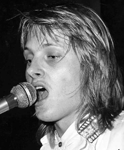 |
As usual there was the reek of
cigarettes, pot, and beer, but there was always a few groups of hard-core
Skogie fans who were really into the deeper
aspects of the music.
|
| By Laura
Fissinger
Minneapolis Reader
1980 |
The first night I ever heard contemporary power-pop
and the first night I ever saw Frederick "Rick" "Skogie" Moore were
the same unerasable evening. It was at a University dance circa 1972, a
time when it seemed like every other ambitious local band wore lots of
purple satin and learned their key riffs off the Yes album. During the
Elvis classic "Teddy Bear," Moore whipped out the real item and
proceeded to fearlessly demonstrate some arcane maneuvers of stuffed
bear-human being relations.
Years later Moore and
his boys were forever banished from
Miraleste, a Palos Verdes penninsula High School in California for the same
inventive play of passion.
Some urges never
die.
Skogie released a single in June 1972 with the
help of producer/manager David
Zimmerman (Bob Dylan's brother), and
released a follow up album in 1974.
Moore's band was later acknowledged by no less than Creem magazine as having
been one of the first power-pop bands known to man; during their six-year
residency (1970-1976) as Minneapolis' strangest, they were indeed an
anachronism.
California laid claim to Skogie (four out of five Kats belonged to that band) in 1976, after extensive national touring
and recording experience at three Minneapolis studios hinted at unexplored
musical and circumstantial possibilities. Los Angeles was not clutching
it's breast in anticipation. "The reception was as abysmal as you can
imagine," Moore laughs now. For a good while the band did a Jekyll
and Hyde. Skogie also played original music dates as the Kats, while
Skogie
became a dance band doing lots of cover material, lassoeing lots of fans,
and happily rediscovering unmitigated pop after trying other genres for
size. There were moments of longing for home on the range. "One of the
first things we found out is that Minneapolis audiences respond to a much
more intellectual performance than L.A. audiences. And in
L.A., attitude is crucial. They want to be told what's hip. The bands
simply have to act like they know what they're doing, no two ways about
it."
Hip in El Lay circa 1978 had it's
finger pointed to new wave. "We were in the right place at the right time
- making bad business moves.
|
| By Laurie Bereskin.
L.A.Daily News
1979
|
Frederick G. Moore soon became the San Fernando
Valley's answer to England's Jeff Lynne, the guiding influence behind the
Electric Light Orchestra. Although ELO's orchestrated pop style bears
absolutely no resemblance to the rocky bebop sound of Moore's group, The
Kats, the two bands have one thing in common -- strong
leadership.
Like Lynne, Moore functioned as his band's lead singer,
rhythm guitarist, sole composer and conceptual designer. But Moore
carried his role as star cat one step further.
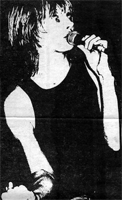 |
Onstage he was riveting,
especially when he unstraped his guitar midway through each
set. Unencumbered, Moore prowled the stage in search of his
quarry. He often bypassed his fellow band members -- younger
brother Bobbyzio (sax),
Dennis
Peters
(bass and vocals), Al Galles (drums and vocals), and
Pete McRae (lead guitar) in favor of forays into the
audience.
Young girls responded by enticing Moore
toward them with promises of cat food tidbits from Purina and
Friskies boxes.
| The
other Kats were pelted with handfuls of dry kibble while Moore
bounded back on stage, scrambled on top of an amplifier, and made
dramatic feline leaps, marking the end of one song and signaling the
beginning of the next.
When it came to everyday life,
however, Moore's nervous system sliped into a relaxing lower gear.
Stripped of his flamboyant stage mannerism's, he came across as an affable
fellow, who looks rather intellectual due to the thick black rimmed
glasses he wears when not performing. And it soon became apparent that his
appearance was not deceiving since Moore's conversational wit revealed a
sharp mind.
The Kats uniqueness was largely the result of one of Moore's most
engaging concepts -- an individual appropriately named Freddy, an
underdog or in this case an underKat. Buoyed by the band's good-natured
rock 'n' roll vibes, this song pattern eventually evolved into a rock
opera of sorts. The theme was so subtly presented that Moore's songs did
not seem contrived, unlike many rock concepts. "We don't serve up a plot
per se but each number ties into the next," explained Moore.
"Freddy's problems continually crop up throughout
the group of songs we perform during each set."
Moore said he has enlarged upon his own personality to create the
character he portrays on stage. "Freddy's just an inexperienced little guy who's
not really cool but constantly tries to convince his friends, as well as
himself, that he truly is a cool individual. I used to be and probably
still am, a nervy, punky kid living in suburbia always fantasizing about
being where the action is."
He threw up his hands in amused exasperation and laughed. "Here I am,
living in Arleta and its all happening on the Sunset Strip. That's the
message behind "Street Life" in which Freddy sings of his longing to escape from the
dull routine of middle-class suburban life."
"He dreams about hanging out in an area like the West Hollywood rock
scene but his dad won't let him have the car, his friends won't cart him
out there and he's too chicken to hitchhike. So Freddy has to stay
home and live vicariously by reading rock magazines. Our theme song,
'The Kats' relates directly to
this situation of being stuck inside like a house cat who's only
desire is to jump through the screen door and join all the free
roaming alley cats outside."
Of course Moore was no longer stranded in suburbia. He may have lived
in the northern outskirts of the Valley but his status as
lead singer in a popular local attraction was anything but dull. In the
song "My Life's In The Bag," Moore posed the question: Where do we go from
here?
The answer to Moore's question
appeared obvious. The Kats, who were on the verge of signing a recording
contract, were more than ready to graduate from the local L.A. rock scene.
|
| (editor) |
Note: Around this time Moore met his second wife
Demi (the relationship lasted 6 years).
Infinity Records won the bidding war and rushed The Kats into
Shelter Studios on Sunset with Tom Petty's production team. Just as
final mixes were being completed Infinity Records was disolved by
its Dutch parent company. There was no one left to pay the Shelter
Studio bill so "
The Kats - Get
Modern
" became known as "The Great Lost
Kats Album". It remains locked in the Shelter Studios
vault.
Here are some newspaper
reviews from that era: |
|
By Milt Petty
L.A. Daily News
1979
|
Moore had time for only eight of his tunes but was
able to show a clear thematicawareness that his life in the Valley
is both separate from and entirely similar to that of his new wave
colleagues. When Moore does their theme song, "The Kats," they become an interesting visual
group as well.
Musically, the Kats have a lot in common with the
spiritedness of the '50s sax-influenced groups stretching clear back to
Bill Haley and the Comets; they've also digested the mid '60s first
generation punk and have a clear understanding of the technical advances
made in the '70s.
|
|
By Ken Tucker
L.A. Herald Examiner
1979
|
The cartoon star of the Kats is lead singer-songwriter Freddy
Moore, a runty fireball who looks like Frank Gorshin after being hit
on the head – by an anvil, undoubtedly. Moore
begins hopping his little body around the stage the instant the spotlight
hits him, and once started, he never stops: He pops his eyes, flails his
arms and bends his fingers in time to the beat, acts out his songs with
gestures so broad they become visual puns, and leaps into the audience to
literally collar an innocent patron into loving him.
Oh yes, Freddy also sings. He sings in a scratchy but muscular
voice over the raucous wails of two guitars and the saxophone of
Bobbyzio Moore, who with his spiky-kooky hair and herky-jerky stage
moves complements Freddy Moore to an appallingly fitting degree (as a friend remarked, is it
possible that both of these boys issued from the same poor
mother?).
|
|
By Laurie Bereskin.
L.A.Daily News
1979
|
|
Bobbyzio Moore on tenor sax and guitar and brother Freddy
Moore on lead vocals and rhythm guitar, are the most colorful cats
onstage. Once he sheds his guitar, frontman Freddy slinks about the stage and into
the audience radiating the sort of cool assurance one associates with an
aggressive tomcat.
Although Freddy Moore is slenderly built along the lines of
a Mick Jagger, he quickly demonstrates that housed in his slight body are
a pair of superman lungs. He's a first-rate singer who punctuates his
solid gutsy vocal delivery with earthy growls.
|  |
|
| (editor) |
Shortly after the Infinity Records fiasco lead guitarist
Pete McRae
departed. The four remaing Kats renamed themselves
the Nu Kats
, fired their management, signed with Rhino Records, recorded
"
Plastic Facts
" and filmed the video "It's Not A
Rumour" featuring
co-writer, wfie and soon-to-be-famous actress
Demi Moore , which went into rotation on
MTV
.
|
|
Harold Bronson
Rhino Records
President
|
Most manic of all
is Clark Kent-ish Freddy Moore. While he appears totally in control
on stage, in his personal life Moore is a one-man sandtrap. Once, on his
moped, he crashed into a truck and broke both legs. His day-to-day
turmoil includes knocking over drinks, and stumbling along in
romance. In
"Shoplifter" he sings about trying to cope while dreading the clobbering
he'll get from his mom when she finds out. Actually Moore feels good about all these anxieties,
as it gives him the inspiration for writing.
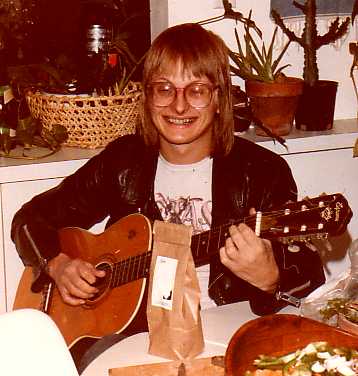
| Freddy Moore offstage.
Los Angeles, California.
New Year's Day 1980.
|
|
| (editor) |
The Nu Kats disolved in 1981. Moore moved to the upper westside of Manhattan and joined local NYC band "The Dates". "I answered an ad in the Village Voice that read
'Wanted: Lead Singer/Lead Guitarist influenced by Squeeze and The Beatles'". Moore became a Singer/Guitarist/Composer of The Dates
"I loved NYC and had a lot of fun being a member of The Dates, it was nice to have Bob Fruhlingher handle the band leader duties, I was able to focus on what I enjoyed."
While living in New York there was a family illness so Moore hopped on a plane for UCLA Medical Center. "I rang up Bob Fruhlinger
of The Dates and asked them to liquidate my NYC possessions". Moore remained in LA and formed a new band called BOY (v1).
BOY was more pop than any previous Moore band. BOY (v2) released a record on Radioactive and Freddy received a SAG/AFTRA card while portraying 'Arn' in the 3-D film 'Parasite' (BOY (v1) can be heard on the soundtrack.
In 1983 BOY disbanded.
| 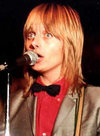 |
The Moore Brothers continued writing, arranging and
recording new material for another year-or-so. They even put a band
together and played a few industry showcases as:
BFM (Bobbyzio and
Freddy Moore). In 1985, after a 6 year
relationship, Demi and Freddy divorced. Moore officially
retired from the music business.
Note:
in 2005 Moore married his thrid wife Renee after several decades of
courtship.
When I was forced out of retirement by my day-job employers (1990) I wrote a bunch of
new songs for The Kat Club! -note: "we still haven't finished recording them all!"
Moore (and Peters) lost their day jobs in 2010, and returned to the stage, as
"Freddy Moore & Dennis Peters <Acoustic Duet>"
Performing at acoustic songwriter showcases in L.A.
The Kat Club! has released 3 CDs ('House Combinations', 'Source Mississippi' and 'los angelenos') and are currently tracking CD#4 'The Sixties'
(coming soon). 

Revisiting the
Mississippi 2000. Nicollect Island,
Minneapolis,
Minnesota. | |


 Demophonic Home Page. |
Discograhpy. |
The KAT CLUB Story.
Demophonic Home Page. |
Discograhpy. |
The KAT CLUB Story.